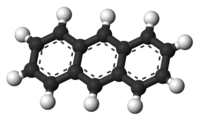Anthracene
| Anthracene[1] | |
|---|---|
 |
|
 |
|
|
Anthracene
|
|
| Identifiers | |
| CAS number | 120-12-7 |
|
SMILES
c1ccc2cc3ccccc3cc2c1
|
|
| Properties | |
| Molecular formula | C14H10 |
| Molar mass | 178.23 g mol−1 |
| Appearance | Colorless |
| Density | 1.25 g/cm³ at 19.85 °C, Solid 0.969 g/cm³ at 220 °C, liquid |
| Melting point |
218 °C, 491 K, 424 °F |
| Boiling point |
340 °C, 613 K, 644 °F |
| Solubility in other solvents | Water: none Methanol: 0.908g per liter Hexane: 1.64g per liter |
| Hazards | |
| EU classification | Dangerous for the Environment |
| Except where noted otherwise, data are given for materials in their standard state (at 25 °C, 100 kPa) |
|
| Infobox references | |
Anthracene is a solid polycyclic aromatic hydrocarbon consisting of three fused benzene rings. It is a component of coal-tar. Anthracene is used in the production of the red dye alizarin and other dyes. Anthracene is colorless but exhibits a blue (400-500 nm peak) fluorescence under ultraviolet light.
In 2010, a strong absorption band of anthracene was observed along a line of sight to a star in the open cluster IC 348, and this may be associated with an intervening molecular cloud.[2]
Contents |
Production
Commercial anthracene is obtained from coal tar, common impurities being phenanthrene and carbazole. A classic laboratory method for the preparation of anthracene is by cyclodehydration of o-methyl- or o-methylene-substituted diarylketones in the so-called Elbs reaction.
Reactions
Anthracene photodimerizes by the action of UV light:
The dimer is connected by a pair of new carbon-carbon bonds, the result of the [4+4] cycloaddition. The dimer reverts to anthracene thermally or with UV irradiation below 300 nm. The reversible dimerization and the photochromic properties of anthracenes are the basis of potential applications. Substituted anthracene derivatives behave similarly. The reaction is affected by the presence of oxygen.
Reduction of anthracene generally yields 9,10-dihydroanthracene (destroying the aromaticity of the center ring) rather than 1,4-dihydroanthracene (which would destroy the aromaticity of one of the terminal rings). This preference for reduction at the 9 and 10 positions is explained by the fact that aromatic stabilization energy is directly correlated with the number of conjugated pi bonds in an aromatic system. Since 9,10-dihydroanthracene essentially preserves two "benzene" rings (a total of 6 conjugated pi bonds), whereas the 1,4-isomer only preserves one and a half such rings (a total of 5 pi bonds), the latter is not the thermodynamically favorable product. Similarly, electrophilic substitution occurs at the "9" and "10" positions of the center ring; oxidation occurs readily, giving anthraquinone, C14H8O2 (below).
Uses
Anthracene is mainly converted to anthroquinone, a precursor to dyes.[3]
Anthracene is an organic semiconductor. It is used as a scintillator for detectors of high energy photons, electrons and alpha particles. Plastics such as polyvinyltoluene can be doped with anthracene to produce a plastic scintillator that is approximately water equivalent for use in radiation therapy dosimetry. Anthracene's emission spectrum peaks at between 400 nm and 440 nm.
It is also used in wood preservatives, insecticides, and coating materials.
Derivatives
A variety of anthracene derivatives find niche uses. Derivatives having a hydroxyl group are 1-hydroxyanthracene and 2-hydroxyanthracene, homologous to phenol and naphthols, and hydroxyanthracene (also called anthrol, and anthracenol)[4][5] are pharmacologically active.
Toxicology
Unlike other polycyclic aromatic hydrocarbons (PAH), anthracene is not carcinogenic but has been recently included in the Substances of Very High Concern list (SVHC) by the European Chemicals Agency (ECHA) [1] because it is considered Persistent, Bioaccumulative and Toxic (PBT) for freshwater and marine ecosystems [2] within the REACH framework. Anthracene, as many other PAHs is generated during combustion processes: exposure to human happens mainly through tobacco smoke and ingestion of food contaminated with combustion products [3].
See also
- Phenanthrene
- Tetracene
- 9,10-dithioanthracene, which migrates in a straight line when adsorbed on a flat copper surface.
References
- ↑ NIST Chemistry WebBook Anthracene
- ↑ Iglesias-Groth, S.; Manchado, A.; Rebolo, R.; Gonzalez Hernandez, J. I.; Garcia-Hernandez, D. A.; Lambert, D. L. (May 2010). A search for interstellar anthracene toward the Perseus anomalous microwave emission region. Bibcode: 2010arXiv1005.4388I.
- ↑ Gerd Collin, Hartmut Höke and Jörg Talbiersky "Anthracene" in Ullmann's Encyclopedia of Industrial Chemistry, Wiley-VCH, Weinheim, 2006. doi:10.1002/14356007.a02_343.pub2
- ↑ 1-Hydroxyanthracene NIST datapage
- ↑ 2-Hydroxyanthracene NIST datapage
External links
- International Chemical Safety Card 0825
- IARC - Monograph 32
- National Pollutant Inventory - Polycyclic Aromatic Hydrocarbon Fact Sheet
- European Chemicals Agency - ECHA
|
||||||||||||||
|
|||||||||||||||||

